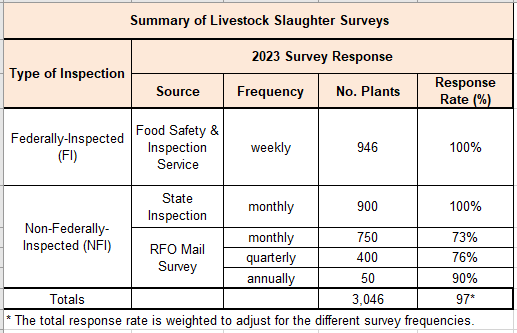0005 - Livestock Slaughter 2023 - SSB - October 2023
0005 - Livestock Slaughter 2023 - SSB - October 2023.docx
Livestock Slaughter
OMB: 0535-0005
Supporting Statement – Part B
LIVESTOCK SLAUGHTER
OMB No. 0535-0005
COLLECTION OF INFORMATION EMPLOYING STATISTICAL METHODS
1. Describe (including a numerical estimate) the potential respondent universe and any sampling or other respondent selection method to be used. Data on the number of entities (e.g., establishments, State and local government units, households, or persons) in the universe covered by the collection and in the corresponding sample are to be provided in tabular form for the universe as a whole and for each of the strata in the proposed sample. Indicate expected response rates for the collection as a whole. If the collection has been conducted previously, include the actual response rate achieved during the last collection.
All known plants that slaughter cattle, calves, hogs, sheep, goats, or bison are targeted by this information collection. Reporting of federally-inspected (FI) slaughter data is done through a cooperative arrangement between USDA’s Agricultural Marketing Service (AMS), Food Safety and Inspection Service (FSIS), and the National Agricultural Statistics Service (NASS). Since reporting this data is mandatory, the response rate is typically 100 percent.
Many states have inspection laws that require some or all plants that are not included in the FSIS inspection program to be inspected by the state. Slaughter data for approximately 56 percent of these non-federally-inspected (NFI) plants are reported to NASS Regional Field Offices (RFOs) by state inspectors. The remaining plants are contacted directly by the RFOs.
The table below summarizes recent population counts and response rates. The FI proportion of total commercial slaughter is typically very high each year. In 2022 approximately 98.1 percent of cattle, 98.1 percent of calves, 99.5 percent of hogs, and 84.9 percent of sheep slaughtered were federally inspected. Since the FI plants account for approximately 99.0 percent of all livestock slaughtered for red meat, the coverage-weighted response rate is nearly 100 percent.
2. Describe the procedures for the collection of information including statistical methodology for stratification and sample selection, estimation procedure, degree of accuracy needed for the purpose described in the justification, unusual problems requiring specialized sampling procedures.
The FI Slaughter data are collected through a census of all known FI plants that slaughter cattle, calves, hogs, sheep, goats, or bison. FI livestock slaughter is reported under a cooperative arrangement between USDA’s AMS, FSIS, and NASS. FSIS federal meat inspectors are responsible for compiling FI data for all federally-licensed plants and submitting the data electronically to FSIS. The data is then sent to NASS on a regular basis. Weekly FI head slaughtered, live weight, and dressed weight by species and class are then summed to a monthly total and summarized together with NFI monthly totals to estimate commercial red meat production in the United States.
NFI Slaughter data are also collected by census design. However, each NASS RFO accounts for NFI slaughter differently, depending on a particular state’s inspection regulations. Many states have inspection laws that require some or all plants that are not included in the FSIS inspection program be inspected by the state. Slaughter data for approximately 60.6 percent of the NFI plants are reported to NASS RFOs by state inspectors. The remaining NFI plants are contacted by NASS RFOs either on a monthly, quarterly, or annual basis to collect livestock slaughter data by month. Field office statisticians review the NFI reports for reasonableness prior to transmitting the data to NASS Headquarters.
3. Describe methods to maximize response rates and to deal with issues of non-response. The accuracy and reliability of information collected must be shown to be adequate for intended uses. For collections based on sampling a special justification must be provided for any collection that will not yield "reliable" data that can be generalized to the universe studied.
The inspections are complete enumerations rather than samples. The monthly livestock slaughter data are collected and reported by FSIS inspectors as the slaughter is taking place, therefore the degree of accuracy is very high. Since reporting the FI data is mandatory by FSIS, the data are highly reliable, with all plants typically reporting. The system utilized by NASS to edit and summarize data includes a check of the current week’s data against historical averages for the plant to ensure accurate reporting.
4. Describe any tests of procedures or methods to be undertaken.
No test of procedures is planned as much of the data collection is mandated by federal or state regulations.
5. Provide the name and telephone number of individuals consulted on statistical aspects of the design and the name of the agency unit, contractor(s), grantee(s), or other person(s) who will actually collect and/or analyze the information for the agency.
Survey design and methodology are determined by the Summary, Estimation, and Disclosure Methodology Branch in Methodology Division; Branch Chief is Jeff Bailey, (202) 690-8141.
Data collection is carried out by NASS Regional and State Field Offices, the Director of Western Field Operations is Troy Joshua (202)720-8220. The Director of Eastern Field Operations is Jody McDaniel (202)720-3638.
The Livestock Branch administers the NASS Livestock Slaughter Surveys; Branch Chief is Travis Averill (202) 720-3570. The commodity statistician is responsible for coordination of sampling, questionnaires, data collection, data processing, field office support, national and regional summaries, and publication.
October 2023
| File Type | application/vnd.openxmlformats-officedocument.wordprocessingml.document |
| File Title | DRAFT |
| Author | Hodgbe |
| File Modified | 0000-00-00 |
| File Created | 2023-12-12 |
© 2025 OMB.report | Privacy Policy
